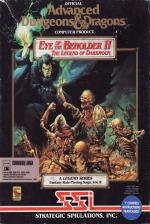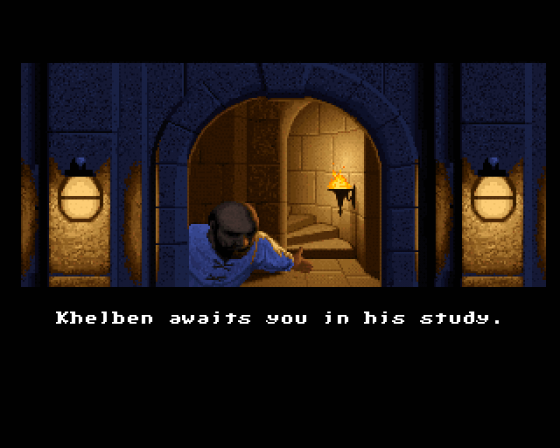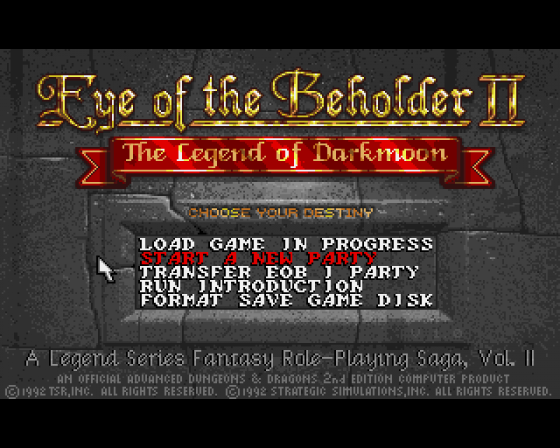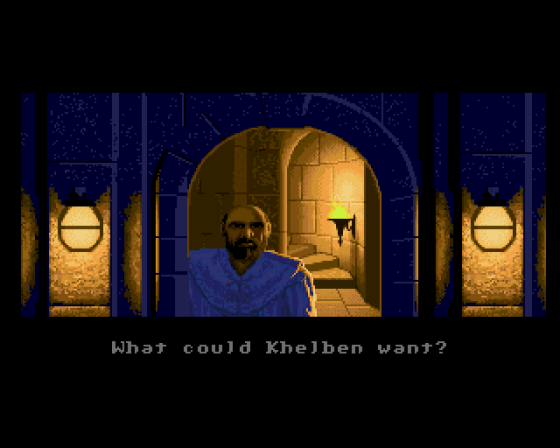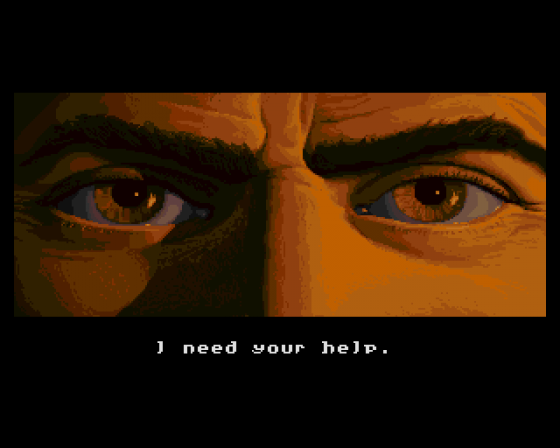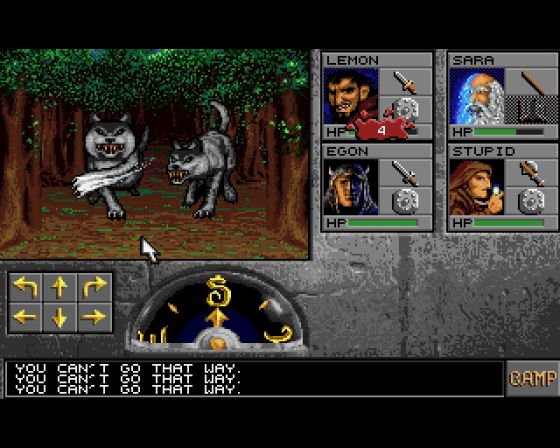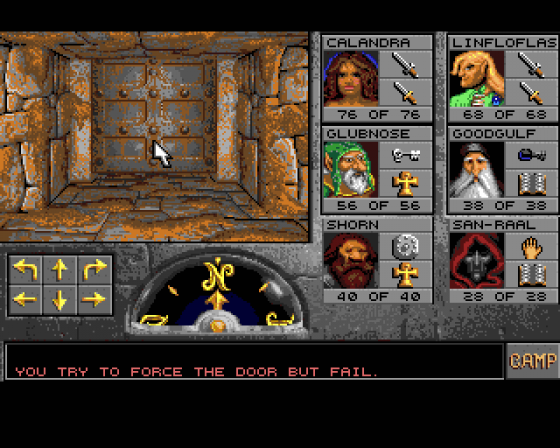
Amiga Power
 1st June 1992
1st June 1992
Author: Karl Foster
Publisher: U. S. Gold
Machine: Amiga 500/500+/600/1200/2000/3000/4000
Published in Amiga Power #14
Eye Of The Beholder II
It was just over a year ago that the world went crazy over the first Eye Of The Beholder. Can SSI keep the fire burning, or does the fantasy role-playing backlash start right here?
The original Eye Of The Beholder proved quite a hit when it was first gulped down the gullet of the role-playing fraternity a year or so ago. For many it is the established benchmark in RPGs - and the one to finally knock FTL's of-late-crusty-looking Dungeon Master off its throne.
Why is this? Well, Eye Of The Beholder's hardcore appeal is unsurprising, as it not only carries TSR's Advanced Dungeons & Dragons endorsement, but implements many of the second edition game rules. For the casual dungeoneer, less interested in the finer points of the AD&D game system, it's appealing too - featuring swish graphics, a funky plot and, above all, gripping gameplay. So gripping, in fact, that Amiga Power bestowed on it a very respectable 88 percent in our first ever issue.

So, 'yum, yum, can we have some more please?' being the verdict, what can its successor offer? It is billed as bigger, better and meaner than ever - no small claim considering its dad. Though senior associated producer Nick Beliaett admits, "It's a tenuous sequel to the first one, as are most sequels," all the signs are that it's a bigger, better game than its predecessor. Hey - with thirteen man-years of development ploughed into it you'd expect something pretty damn expansive...
Plotwise, Eye Of The Beholder II: The Legend Of Darkmoon takes up where its forbear left off. You can even port your old party members from the first game into the second - along with all their hard-won accountrements - provided you're still on speaking terms with them. Of course, we've not all played the original Eye Of The Beholder, but not to worry -you can easily create a brand spanking new (and suitably tough) party from the very comprehensive character generation section.
The story, then. Veterans will recall their perilous slog through the monster-ridden sewers beneath the city of Waterdeep but, for all that parties' brave efforts, even still haunts the world of Forgotten Realms. People are disappearing from nearby villages and Waterdeep's Archmage Khelben wants your four heroes to get it all sorted. (Why he can't manage it himself, what with being an Archmage and all, is never made clear.) One plush animated intro later, your merry band is teleported to the start of their quest - deep inside the dark woods near the Temple Darkmoon.
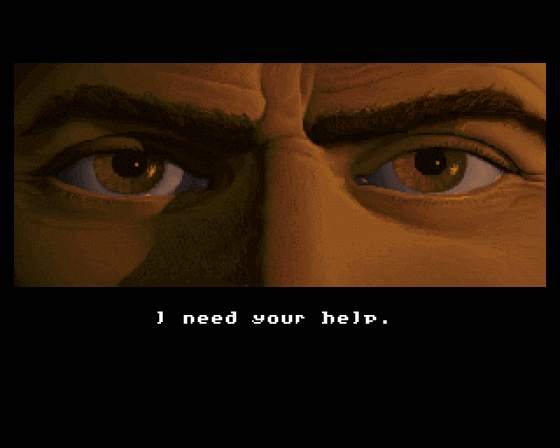
First observations first. Well, we find ourselves with a familiar mouse- and keyboard-driven interface which, while initially tricky to get used to (he smote the wolf with a mighty click on his inventory - oops) soon becomes second nature. As the party hops one click at a time through the wood, which must be a hoot to watch for the outside observer, vicious wolves prowl its regular avenues - obviously a land in which landscape gardeners abound. Old parties will have little trouble wiping out the wolves, and even newly generated ones, which start off at around level six, are similarly tough. There are oddments to be found - rocks for throwing, an old drow (very naughty elves) hideout - but turning a wolf to much with a couple of swift swipes is not what I'd call the most action-packed way to kick off a game. Considering how hard your characters are, I'd question this section being in the game in the first place.
Elementary My Dear Reader
Things hot up fairly swiftly once inside Darkmoon, however. We're presented with the temple itself - plus catacombs beneath and three towers above - to explore, making this one huge mutha of a game. There are four levels through which to progress, each relating to the elements of fire, earth, air and water, and each colour-coded - pointlessly subtle, but I love it. The monsters start off tough and get rapidly tougher, so you'll have to make sure the party rests up between progressively more violent encounters. This isn't easy stuff - so hard, in fact, that I think a hint might be in order, so here it is: there's a room in the catacombs you can use as a bolt-hole when the party's feeling particularly pummelled, and there's a resurrection chamber not very far away too - if you can figure out how to work it.
What else? Well, pleasingly, non player character make regular chatty cameo appearances - more so than they did in Eye Of The Beholder - by which the plot is carried along. These often amount to little more than a pretty picture and some words, but there are some interesting encounters in which you're not quite sure whether you should clobber who you've come across or help them out - some monsters will wibble on amiably just prior to stabbing you in the back!

Occasionally you'll chance upon someone - or something! - that will join your party and fight alongside you. An early encounter will see a halfling thief called Insal tagging along but, with his chaotic neutral alignment, you're never quite sure if you should trust him. This, along with the characters' new-found environmental 'awareness' - walk past a hidden door and someone in the party will mutter that they feel a draught - really helps to draw you into the game world. It's not long before you start thinking of the party as individuals rather than a multi-legged killing machine (an accusation levelled at most multi-character RPGs).
When you get into a scrap though, and there are plenty of them, it all goes bonkers. Deft mouse manipulation is needed to keep the front-rank fighters attacking, while the magic users lob spells from the back; it can get really frenetic as you see the party's hit points dwindle away while more evil creatures come piling in. Animation during the fighting is pretty much the same as the original - jerky, three-frame sequences - but you'll spend more time whizzing your cursor around the weapons icons and spells lists than watching rheumatic monsters grind through their moves.
The graphics, though differing slightly from Eye Of The Beholder, are of a similar high standard and the sound effects remain exactly the same, right down to the eerie, echoing footsteps that do so much to put the willies up you. There are puzzles aplenty to contend with and ominous hints from the party about the likely outcome of pulling a level or inserting a key in a booby-trapped lock. It all conspires to create a terrific atmosphere, so edgy that it's almost a relief to come across a monster for a good old cathartic thrash.

A good solid game then, great even, but there remains a problem. The Legend Of Darkmoon, while being just that little bit better and more involving than Eye Of The Beolder in almost every area, is not the huge leap for dungeonkind I'd hoped it would be. A new plot, a bigger game world, a wider variety of nasties and more mind-stretching puzzles; it's all there, but it's still more of the same.
That's not to knock it - fans of the original will love the game, and it still sits head and shoulders above many other RPGs. I suppose I've been spoilt by the 360-degree animation and glorious auto-mapping of Origin's Ultima Underworld (sorry folks, it's PC only) - this is still one of the two or three best RPGs available for the Amiga. Keep your fingers crossed for Eye Of The Beholder 3 then - which promises new and radical features for Amiga players - but in the meantime, enjoy this one. It's well worth a look and should take you absolutely ages to conquer.
The Generation Game
One of your first tasks when playing Eye Of The Beholder II is to sort out a party of adventurers for yourself. Character generation is by the good old AD&D method - take a racial type, give it a bunch of attributes and fiddle them. The usual motley assortment of Tolkien-esque races are offered: human, elf, dwarf, halfling, gnome (OK, so Middle Earth had no gnomes) and various mongrels, along with a number of different alignments - the philosophy, if you will, by which the character deals with the world.

Lawful good is a complete goody-goody while, at the opposite end of the philosophical spectrum, chaotic evil represents the attitude of a computer magazine publisher with a hangover.
Then there's a variety of jobs, or character classes, to be had: fighter, mage, thief, cleric, paladin or ranger. Alignment has some bearing on this lot, as does race - you can't have an evil gnome doing the job of a paladin, for example - but the greater consideration is a character's ability scores. Fighters obviously need great strength, while mages need intelligence and clerics need huge dollops of wisdom.
To create a character, you get the computer to randomly roll for attributes and, going on whatever attribute has the highest score, that will determine what kind of job the character will do. However, it's possible to bodge the figures. Just select the appropriate attribute, hit a few times and you've got a bunch of superhumans/elves/dwarves/halflings/gnomes with more muscle, brainpower and personality than a team of Olympic weightlifters solely comprising Carol Vordemann. This, as you may well have guessed, is exactly what I do every time I play the game...
Spellbinding Stuff
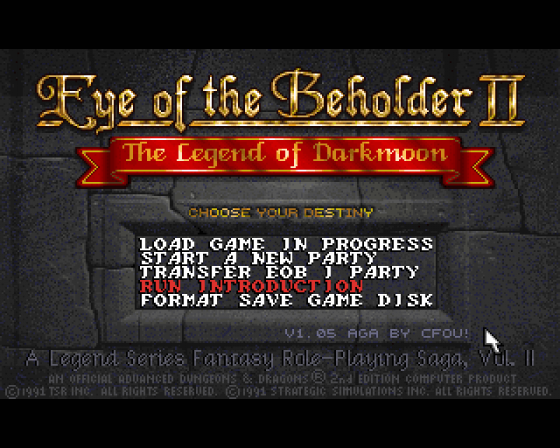
One gripe I've always had with AD&D is that, under the normal rules, you can't go making up your own spells - it was this obvious failing in the SSI stuff that helped make Mindscape's Legend (also reviewed this issue) look so good, for instance. Eye Of The Beholder II looks very sorry in comparison - you're limited to a selection of mage and cleric spells (depending on which type of character you're dealing with at the time) which becomes wider as the characters go up in level.
So what happens? Well, a mage character will memorize spells from a set list while the party rests - it's a bit of a bummer, for as soon as he/she casts a spell, it's instantly forgotten. (And I thought these ultra-powerful mage types were supposed to be a bit clever!) Clerics, meanwhile, pray for spells (high-level paladins can do exactly the same trick).
It doesn't end there though. Mages have a rather more offensive arcade arsenal, with fireballs, disintegration and ice storms all available at higher levels, while clerics fall more into a nursing and personnel role and are able to cure wounds and pray for better combat ability during a scrap - though they can still give you a nasty flame strike if rifled.

All this firepower places some restrictions on a magic user's resilience. Mages can wear no armour and clerics can only use blunt weapons, so it's best to keep them out of the front rank as much as possible.
The Bottom Line
Uppers: Eye Of The Beholder fans will be in hog heaven. More of the action-cum-brain-burning same, plus a little bit extra, from an RPG game engine that has already proved itself just about the best there is. A good solid, well thought out game, with lots of neat touches.
Downers: Good though it is, this isn't quite the major advance on the original that we'd all hoped for, particularly in terms of animation. And please can we have auto-mapping next time?
A must for the dedicated RPG enthusiast (deja vu anyone? Yes, we have said that a few too many times lately...) and, in tandem with the original, makes for an utterly huge world in which you could fritter away weeks of your life.
Not such a huge leap in RPG standards as the first game was - which makes it a bit disappointing - but still an excellent game.

